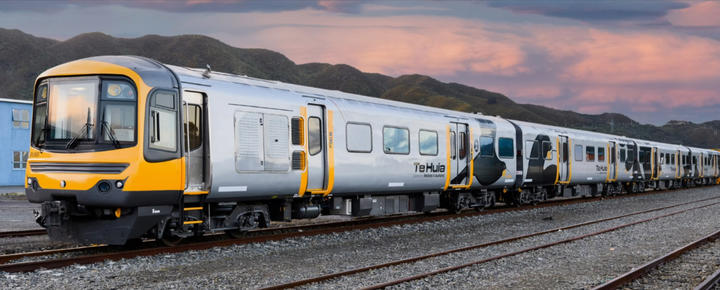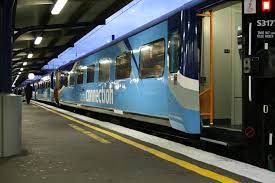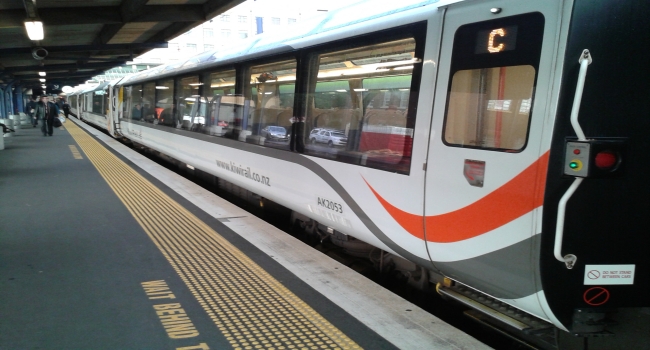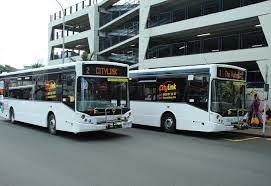Opinion - With the opening of the Hamilton to Auckland inter-regional passenger train service, long distance rail lines are in for upgrades and discussion, Michael Nicholson looks at the state of play for regional, inter-regional and long distance passenger train services in the North Island of New Zealand.
Te Huia – Hamilton to Auckland
Fledgling inter-regional passenger rail between Hamilton and Auckland began on April 6 under the brand Te Huia. This route has huge potential to succeed. Growing traffic congestion and regional population growth spurred by more affordable housing, an awareness of our carbon footprint, comfort and the ability to use travel time productively has spurred the interest.

Continuous improvement and ongoing investment will be needed to ensure this route becomes an integral part of our transport network. Government has indicated they are supportive with Transport Minister, Michael Wood saying: “There are a range of potential improvements the Government is exploring, including more stops along the way, different timetables, and expansion beyond Papakura into Auckland.”
Te Huia is a Waikato Regional Council initiative in conjunction with NZTA. It has been funded for a five-year trial and KiwiRail has been contracted to operate services. Currently two morning trains depart Frankton (0546 and 0628), with two afternoon trains south from Papakura (1642 and 1825). There is also a Saturday service with additional off-peak and weekend trains mooted to be added progressively.
Currently passengers change at Papakura to the Auckland Transport (AT) train services. Total travel time from Frankton to Auckland CBD is about two and half hours. Start-up investment includes three train sets (12 carriages total) which were refurbished at the Hutt Railway Workshops. The refurbishing included comfortable seats, toilets, cafe and bar, Wi-Fi and bicycle racks. New or upgraded stations have been created at Frankton, Rotokauri and Huntly with possible new stops at Ngaruawahia, Te Kauwhata, Pokeno and Tuakau to be added in time.
Reopening the central Hamilton underground station or building a new central station close to Seddon Park as well as a new station at Claudelands (east side of river), are being discussed.
Extending trains north to the new Puhinui Interchange is likely to take place sometime in 2021 thus taking trains 12km closer to Auckland CBD, improving overall travel time, giving a direct connection to the Eastern and Southern Lines and doubling available AT (Auckland Transport) trains for transfers.
Possible future options could include running trains in continuous loops out-and-back to Hamilton Finishing electrification from Pukekohe to Hamilton would seem a logical and urgent development. Electric inter-regional passenger trains could then travel directly from the Auckland Central Rail Link tunnel to Hamilton’s CBD and freight and long-distance passenger trains could use clean electric energy between Auckland and Palmerston North.
Capital Connect – Palmerston North to Wellington
This is a well-established inter-regional service which has been operating for around 30 years.
Immediate plans are to replace the current carriages with two refurbished train sets identical to Te Huia. Additional morning and afternoon peak services have been discussed as well as off-peak weekday and weekend services.

The new rolling stock will be used as a shared pool of regional rolling stock operating over both regional Wairarapa and inter-regional Palmerston North routes. There has been talk of some sort of hybrid railcar technology, consisting of possibly fixed four carriage consists. An order of between 15 and 25 railcars has been discussed and it would seem hopeful, from comments in the media, that an order will be at the upper end for reasons of future proofing and reduction of price per set.
Horizons Regional Council has indicated they would eventually like to incorporate Wanganui, Marton and Feilding to the inter-regional passenger rail system.
Auckland to Wellington
KiwiRail is currently undertaking a feasibility assessment on passenger rail services between Wellington and Auckland.
Regional authorities along the North Island Main Trunk (NIMT) have been promoting the introduction of a ‘connector’ passenger train on this route, which connects four major cities and 42% of New Zealand’s population plus numerous smaller centres and a large catchment area not well served by public transport. There are also many attractions in the National Park area, such as skiing, walks, cycling etc, which could be well served by such a service.

The service would have the added convenience of city-centre to city-centre departures, efficient use of time while travelling, ability to connect smaller communities as well as larger ones, act as an economic and tourism enabler, would be a safer travel option than road transport, reduce and avoid road traffic congestion and create significantly less carbon emissions per passenger than other modes.
Auckland to Wellington has been identified internationally as an ideal route to operate modern overnight trains. All measures compare favourably on this route, including: distance, travel time, passenger potential, improved community connectivity, improved travel safety and reduction of carbon emissions in the travel sector.
Modern overnight sleeper travel could serve different needs in the travel market.
Sleepers for longer distance city-to-city connectors would provide comfortable travel at convenient departure and arrival times, between the four major cities along this route. It is the only realistic way to attract people from domestic air travel (which is very polluting), over longer distances.
Seating carriages would cater for shorter trips and also improve travel options and flexibility on the Auckland to Hamilton and Wellington to Palmerston North inter-regional corridors by adding evening departure options. They would connect smaller centres and also provide a convenient option for those people on a limited budget.
Evening departures at around 8.30pm and arriving after 8,30am would avoid commuter peak periods in both Auckland and Wellington. Overnight train travel is not about the speed of a journey but all about convenient departure and arrival times and the comfort of the journey. Twelve hours journey times enable convenient departure and arrival times, make-up time to ensure reliable on-time arrivals, smooth train handling and additional station stops. Modern passenger rolling stock could include innovations such as tight automatic couplers for reduced train slack and for a smoother ride, Wi-Fi and showers.
Day trains
Northern Explorer trains currently operate three times per week focused exclusively on the tourism market. For a daytime connector train to be effective, trains would need to operate daily in each direction. Daytime trains could provide two classes of travel: Tourism Class and Connector Class.
‘Tourism Class’ – Could provide more comfort and a high standard of catering to suit higher paying tourist travellers (domestic and international), aimed at longer distance leisure travellers for which time is not an issue while at the same time servicing business travellers over shorter trips.
‘Connector Class’ – Shorter journeys suited to daylight connector style train travel with six hours seen as the reasonable limit, after which overnight journeys are seen as a more attractive option. This rough guide is promising for this daytime route, given that National Park is centred at the midway point of just over five hours travel time. Daytime connector travel could mainly target National Park attractions, connect towns-to-cities, provide day returns north and south of National Park, and would also complement the Hamilton-to-Auckland and Palmerston North-to-Wellington corridors. Secondarily, it could encourage full journey travel to those people on a limited budget.
New, purpose-built rolling stock would seem to make sense: modern self-propelled, fast acceleration, able to build-up and reduce the size of trains as required, fast self-loading with saloon luggage racks (checked luggage only in ‘Tourism Class’) and large exterior doors for shorter station dwell times. In fact a standard railcar type for New Zealand’s daytime long-distance inter-regional and corridor services could simply be fitted out as required.
The current Northern Explorer AK carriages could be sent to the South Island, forming a consistent South Island carriage fleet perhaps facilitating the initiation of a Christchurch to Dunedin service?
Leadership
KiwiRail pretty much scoffs at any suggestion of passenger rail expansion. They seem perfectly content with their little tourism operation. While this is deeply disappointing to many New Zealanders, especially in light of the many positive developments and massive investment internationally, this position is not entirely KiwiRail’s fault given the limitations of being a State Owned Enterprise.
Central Government has declared a climate emergency and made commitments to reduce carbon emissions in New Zealand. The largest contributor of carbon emissions is the transport sector and passenger rail could make a positive and real difference.
Government policy on reducing carbon emissions needs to be followed up with real alternatives to air travel and road transport.
For progress to be made in developing inter-regional and long-distance passenger rail, responsibility needs to be taken away from regional councils. It is unrealistic to expect a national passenger network to fall out of ad-hoc developments such as Te Huia and the Capital Connection.
Central Government needs to set-up a passenger rail authority, which would coordinate and oversee strategy and the development of a national passenger rail network. This agency needs:
- to be tasked with the develop of a strategy for network development, including corridor service, connector and tourism development plans
- to assess station placement and development opportunities in each community, taking into account catchment areas and integration with other modes
- to aim to provide an easy-to-use, integrated low carbon system
- to develop plans for the purchase of appropriate rolling stock and plan for the introduction of new rail passenger services
This opinion by Michael Nicholson first appeared in the Rail and Maritime Transport Union’s newsletter - Transport Worker and was republished by Greater Auckland on 6 July 2021 with the permission of the RMTU (Rail Maritime Trade Union).


